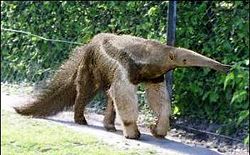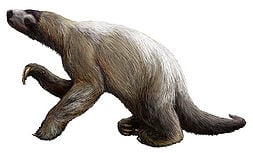Pilosa
| Piloso
| ||||||||||
|---|---|---|---|---|---|---|---|---|---|---|
 Giant anteater, Myrmecophaga tridactyla
| ||||||||||
| Scientific classification | ||||||||||
| ||||||||||
|
Pilosa is an order of placental, New World mammals that includes the anteaters (suborder Vermilingua) and the sloths (suborder Folivora). Like the armadillos (order Cingulata), also of superorder Xenarthra, pilosans are distinguished from other mammals by the presence of xenarthrales (additional, unique articulations between lumbar vertebrae), a double posterior vena cava vein, a divided womb in females, who also have a common genital and urinary tract. They differ from armadillos in that extant pilosans lack armor and have a lot of hair. They are found today mainly in Central and South America, although their range extends into Mexico and southern United States.
Overview and characteristics
The order Pilosa is a group of placental mammals, extant today only in the Americas. It includes the anteaters and sloths, including the recently extinct ground sloths. The name comes from the Latin word for "hairy".[1]
The biogeographic origins of the Pilosa is still unclear,[2] but they can be traced back in South America as far as the early Paleogene (about 60 million years ago, or only a short time after the end of the dinosaur era). The presence of these animals in Central America and their former presence in North America is a result of the Great American Interchange. A number of sloths were also formerly present on the Antilles, which they reached from South America by some combination of rafting or floating with the prevailing currents.
Together with the armadillos, Pilosa is part of the larger group Xenarthra. In the past, Pilosa was regarded as a suborder of the order Xenarthra, while some more recent classifications regard Pilosa as an order within the superorder Xenarthra. Earlier still, both armadillos and pilosans were classified together with pangolins and the aardvark as the order Edentata (meaning toothless, because the members do not have front incisor teeth or molars, or have poorly developed molars). It was subsequently realized that Edentata was polyphyletic—that it contained unrelated families and was thus invalid.
Classification
Order Pilosa
- Suborder Vermilingua
- Family Cyclopedidae
- Silky anteater, Cyclopes didactylus
- Family Myrmecophagidae
- Giant anteater, Myrmecophaga tridactyla
- Northern tamandua, Tamandua mexicana
- Southern tamandua, Tamandua tetradactyla
- Family Cyclopedidae
- Suborder Folivora
- Family Bradypodidae: three-toed sloths
- Pygmy three-toed sloth, Bradypus pygmaeus
- Brown-throated three-toed sloth, Bradypus variegatus
- Pale-throated three-toed sloth, Bradypus tridactylus
- Maned three-toed sloth, Bradypus torquatus
- Family Megalonychidae: two-toed sloths and extinct megalonychid ground sloths
- Hoffman's two-toed sloth, Choloepus hoffmanni
- Linnaeus's two-toed sloth, Choloepus didactylus
- Family †Megatheriidae: megatheriid ground sloths
- Family †Mylodontidae: mylodontid ground sloths
- Family †Nothrotheriidae: nothrotheriid ground sloths
- Family Bradypodidae: three-toed sloths
ReferencesISBN links support NWE through referral fees
| Mammals |
|---|
| Monotremata (platypus, echidnas) |
|
Marsupialia: | Paucituberculata (shrew opossums) | Didelphimorphia (opossums) | Microbiotheria | Notoryctemorphia (marsupial moles) | Dasyuromorphia (quolls and dunnarts) | Peramelemorphia (bilbies, bandicoots) | Diprotodontia (kangaroos and relatives) |
|
Placentalia: Cingulata (armadillos) | Pilosa (anteaters, sloths) | Afrosoricida (tenrecs, golden moles) | Macroscelidea (elephant shrews) | Tubulidentata (aardvark) | Hyracoidea (hyraxes) | Proboscidea (elephants) | Sirenia (dugongs, manatees) | Soricomorpha (shrews, moles) | Erinaceomorpha (hedgehogs and relatives) Chiroptera (bats) | Pholidota (pangolins)| Carnivora | Perissodactyla (odd-toed ungulates) | Artiodactyla (even-toed ungulates) | Cetacea (whales, dolphins) | Rodentia (rodents) | Lagomorpha (rabbits and relatives) | Scandentia (treeshrews) | Dermoptera (colugos) | Primates | |
Credits
New World Encyclopedia writers and editors rewrote and completed the Wikipedia article in accordance with New World Encyclopedia standards. This article abides by terms of the Creative Commons CC-by-sa 3.0 License (CC-by-sa), which may be used and disseminated with proper attribution. Credit is due under the terms of this license that can reference both the New World Encyclopedia contributors and the selfless volunteer contributors of the Wikimedia Foundation. To cite this article click here for a list of acceptable citing formats.The history of earlier contributions by wikipedians is accessible to researchers here:
The history of this article since it was imported to New World Encyclopedia:
Note: Some restrictions may apply to use of individual images which are separately licensed.
- ↑ Kidd, D.A. (1973). Collins Latin Gem Dictionary. London: Collins. ISBN 0-00-458641-7.
- ↑ A proposed clade, Atlantogenata, would include Xenarthra and early African mammals.
